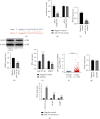CREB3 Transactivates lncRNA ZFAS1 to Promote Papillary Thyroid Carcinoma Metastasis by Modulating miR-373-3 p/MMP3 Regulatory Axis
- PMID: 34249125
- PMCID: PMC8238556
- DOI: 10.1155/2021/9981683
CREB3 Transactivates lncRNA ZFAS1 to Promote Papillary Thyroid Carcinoma Metastasis by Modulating miR-373-3 p/MMP3 Regulatory Axis
Abstract
The incidence rate of thyroid carcinoma ranks ninth among human malignancies, and it accounts for the most frequent malignancy in endocrine-related tumors. This study aimed to investigate the role of long noncoding RNA (lncRNA) ZFAS1 in the metastasis of papillary thyroid carcinoma (PTC) and the potential molecular mechanisms. Both ZFAS1 and MMP3 were highly expressed in thyroid carcinoma and PTC cell, as measured by the q-PCR and TCGA database. In addition, ZFAS1 induced TPC-1 metastasis through inducing the epithelial-mesenchymal transition (EMT) process. Besides, ZFAS1 knockdown by siRNA induced miR-373-3p expression and reduced MMP3 expression, as quantified by q-PCR and Western blotting. According to the luciferase assay, both ZFAS1 and MMP3 were classified as the direct targets of miR-373-3p. However, MMP3 itself did not affect ZFAS1. Using the online prediction tool, CREB3 was predicted as the transcription factor (TF) of ZFAS1 that contained two binding sites on its promoter region, and CREB3 was positively correlated with ZFAS1 in thyroid carcinoma cohorts. Results from the dual-luciferase assay and ChIP-qPCR indicated that both the two binding sites were essential for the transcription of ZFAS1. In conclusion, CREB3 activated lncRNA ZFAS1 at the transcriptional level to promote PTC metastasis by modulating miR-373-3p/MMP3.
Copyright © 2021 Gang Wang et al.
Conflict of interest statement
The authors declare that they have no conflicts of interest.
Figures





References
-
- Haugen B. R., Alexander E. K., Bible K. C., et al. 2015 American thyroid association management guidelines for adult patients with thyroid nodules and differentiated thyroid cancer: the American thyroid association guidelines task force on thyroid nodules and differentiated thyroid cancer. Thyroid. 2016;26(1):1–133. doi: 10.1089/thy.2015.0020. - DOI - PMC - PubMed
LinkOut - more resources
Full Text Sources
Miscellaneous

